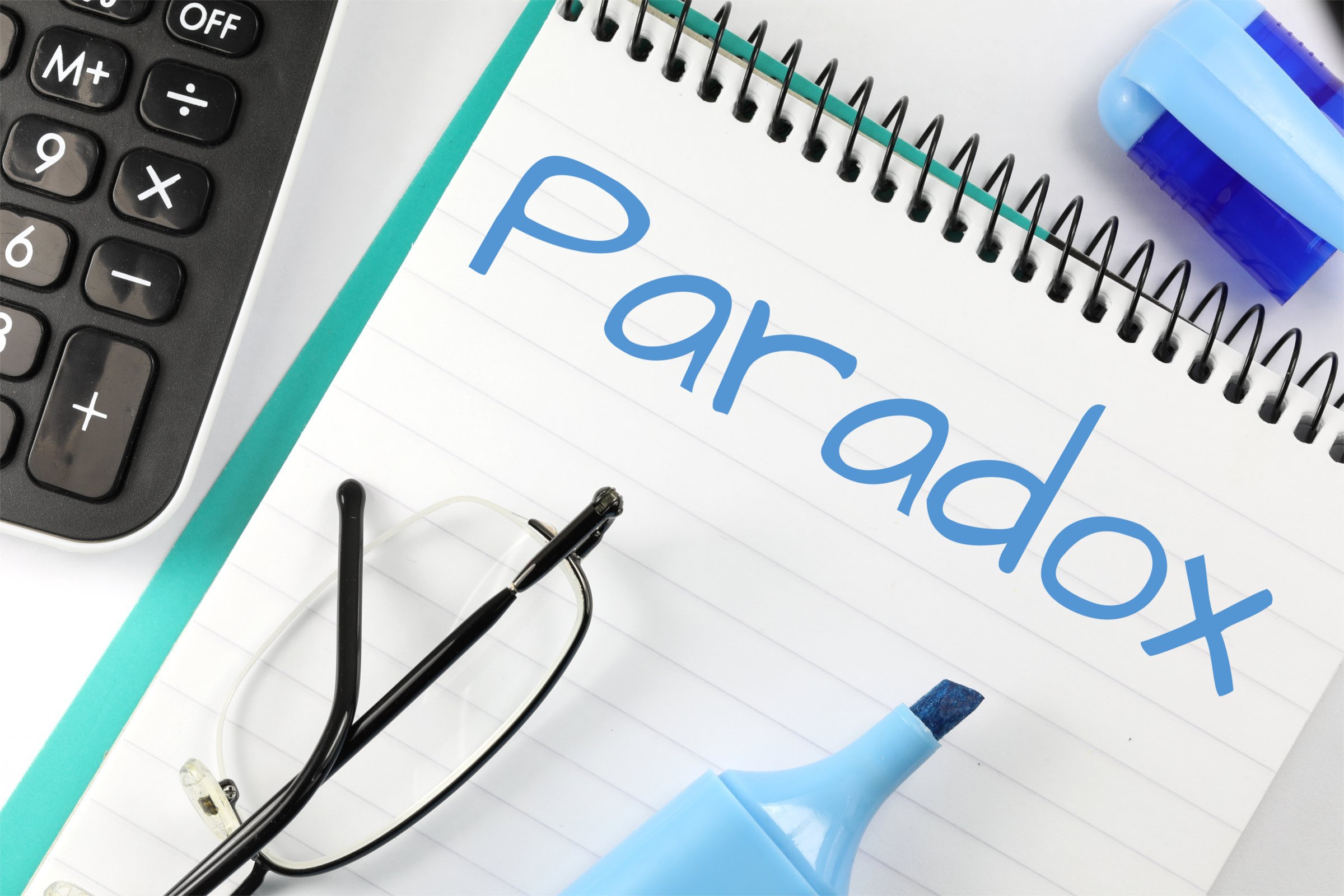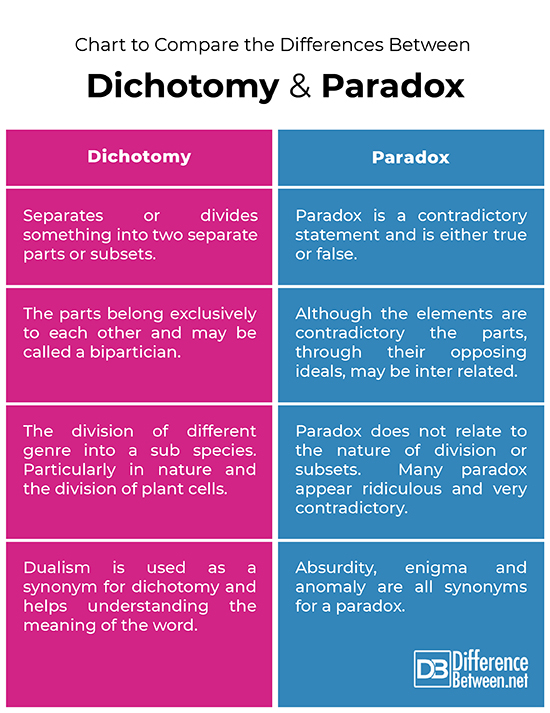Difference Between Dichotomy and Paradox
A dichotomy and a paradox help readers to understand the difference between two words set against each other in a comparative manner. The essential difference between these two concepts is that a dichotomy separates two items into two groups or subsets. A paradox, also separates words into two groups, but each group has an opposite meaning. A paradox contradicts itself, because the words are opposing. The words are not considered to be a paradox unless they are opposing. This means if one is true the other word is false. A paradox may be a contradiction while a dichotomy splits two parts into two non-overlapping entities, fragments from a whole. These parts are subsets of the whole and are opposing in nature and meaning. A very subtle difference.

The Definition of Dichotomy.
A dichotomy can be described as the division of two ideals into two subsets or opposing subclasses. There is, for example, a dichotomy between nature and nurture in raising a healthy, happy child. Another example is the dichotomy between theory and practice. Duality is noted as a popular choice for a synonym for dichotomy as well as paradox. A dichotomy is a classification of two opposing ideas as subsets of an original idea or concept.
Literary use of Dichotomy.
In literature a writer may use a dichotomy to create an atmosphere of conflict. The fight between good and evil is a common theme expressed through stories and plays. The idea of the angel of goodness on one shoulder and a wicked devil on the other is often used to bring out the dilemma of the hero or heroine of the story. The angel and the devil represent opposing emotions or sentiments influencing choices made at that time. Shakespeare used dichotomy to develop the idea of two opposing families in Romeo and Juliet through the Montagues and Capulet families. The families are alike in their social standing, but have been opposed for so long they have forgotten what the dispute is about. The dichotomy is the trivia of their disputes and the deaths that result from their feud.
Contemporary language and literature abounds with dichotomies. Private and public, subject and object, saint and sinner, left and right, are all subsets of a whole and in the partitioning all must belong to one group or the other. Each part is exclusive to the other and nothing can belong to both parts. For example private property can not be for the public and vice versa, but they both speak of property.

The Definition of a Paradox.
A paradox always appears to have contradictions, however in reality, it may express a possible truth. A paradox may be about a person or thing or even a situation that appears contradictory. Paradox is derived from the Greek paradoxos meaning opposed to existing notions. Here is a paradoxical statement to show this difference of opinion.
“We need to be cruel to be kind.”
The two opposite words come together to form a contradiction.
In the same way, logically to say, “I am lying,” means you are telling the truth about being a liar. It is a statement that seems to contradict itself. It can be both true and false at the same time. A paradox sounds reasonable because it is not nonsensical, but it is contradictory. The human condition or behavior is highlighted by paradox. People behave in a paradoxical fashion and paradox adds a further dimension to literary characters.
Sometimes characters in stories meditate and are said to close their eyes so they can see. Not a literal closing of eyes, but a figurative act of closing eyes to meditate and look deeper into the meaning of life. This idea of meditation, closing your eyes to see, is noted in Fugazi’s song, ‘’Shut the door.’’
Paradox is more likely to be attributed to highlighting contradictions and creativity in the literary world. While the world of nature and the natural order of things resonates with sub division and sub species.
Chart to compare the differences between Dichotomy and Paradox:

Summary:
It is no wonder the expression ‘vicious circle’ evolved from looking at a paradox and trying to fathom its beginning and its end. Theory assigned to the concepts of paradox and dichotomy do not make easy reading for the average student. Proving these theories exist is often a complex mathematical theory. Beginnings and ending, how sets are classified and how comparisons are made seem to end with one contradictory thought or another. Looking at equations, unless you are a mathematician do not help with the understanding of these complicated philosophies. It may be easier just to see them as divisions that have a dual nature or abnormal relationships. They do not appear to complement one another and yet they are grouped together in the same paradox. Looking at a dichotomy is probably easier to understand because the division is not based on abstract mathematical theory. Dichotomy in nature is often a natural division of plant or animal material into sets that have a common element. A paradox, with its necessary true and false element, ends up being more confusing as one part of the paradox is not a paradox unless the parts are opposite or contradictory, to one another. In the case of a beginning and an end there can be no beginning without an end and the end will not be there if something does not begin. In the example less is more I can not have less if I did not have some originally. What is the less or more attributed to and how do the quantities make the division of less to understand more a logical process. It all seems contradictory and open to speculation you will find yourself in a vicious circle explaining – less is really more!
Plato, one of the greatest ancient Greek philosophers, wrote this paradox.
“I am the wisest man alive, for I know one thing, and that is I know nothing.”
FAQ: Here are some Frequently Asked Questions answered for you.
What are some examples of a paradox?
Less is more.
Have you heard the statement ‘Less is More.’ It is a paradoxical statement meaning the less you have the more you appreciate what you have.
This is the beginning of the end.
Since there has to be a beginning or starting point there will be an end on the continuum of events. The beginning is necessary to reach an end.
What is the greatest Paradox?
There are many great paradoxical situations. There are some that are mathematical and some are part of nature and philosophy, but the paradox that seems to get most attention from the mathematical world is known as Russell’s Paradox. A paradox behind the theory of sets and their members. This paradox and others have caused deep thinkers like Bertrand Russell to look at the theory and logic as well as the philosophies of mathematics. These paradoxical situations in mathematical language and examples can be very confusing. An exasperating expression evolved from these paradoxical situations, it is known as the ‘vicious circle’.
Reading up on numerous paradox stories or theories will make you feel you are in a vicious circle. Some well known paradoxes are The Dichotomy Paradox, The Crocodile Paradox, The Card Paradox and Achilles and the Tortoise paradox. Achilles Paradox goes back to the ancient Greek philosopher Zeno of Elea and during the 5th Century BC.
What is the difference between a paradox and an oxymoron?
A paradox is a rhetorical device making a statement, while an oxymoron is a deliberate contradiction between two terms. A paradox may be part of a sentence while an oxymoron is two opposing words. The words are deliberately offset against each other. The oxymoron is in fact a paradox reduced to two words. The opposing meanings give dramatic effect to the phrase.
What is the difference between a paradox and a contradiction?
A contradiction is described as a logical incompatibility between two or more items in a statement. The statements form the opposite meaning of each other. In other words it is like saying something is and is not in the same statement. That is a contradiction of terms. A paradox can only be viewed as a paradox when one part of the statement is true and the other false.
- Difference Between Lagoon and Bay - October 20, 2021
- Difference Between Futurism and Preterism - August 12, 2021
- Difference Between Dichotomy and Paradox - August 7, 2021
Search DifferenceBetween.net :
1 Comment
Leave a Response
References :
[0]Editors B D. 4th October 2019. www.biologydictionary.com. Dichotomous Key. Directs People to Identify. Pub Biological Dictionary
[1]Preston Scott. 2016. www.amproject.com Dichotomy and Paradox/The Chrysalis. Pub Longwords.wordpress.com
[2]Bob K 11th June 2016. www.socratic.org Difference between Contradiction Paradox and Irony, Q and A Pub. Socratic Meta.
[3]Image credit: https://pix4free.org/assets/library/2021-05-25/originals/paradox.jpg
[4]Image credit: https://live.staticflickr.com/8670/16264258985_553cc1b7c2_z.jpg

Great explanation of the two terms, well educative! Thank you very much!